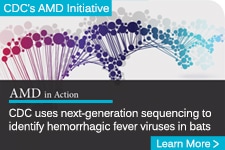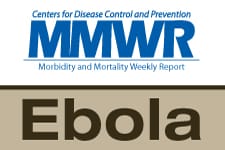Infection Prevention and Control Recommendations for Patients in U.S. Hospitals who are Suspected or Confirmed to have Selected Viral Hemorrhagic Fevers (VHF)
This guidance refers only to the following viral hemorrhagic fevers: Ebola, Marburg, Lassa, Crimean Congo Hemorrhagic Fever (CCHF) and the South American Hemorrhagic Fevers (i.e., those caused by Junin, Machupo, Chapare, Guanarito and Sabia viruses). Refer to the pathogen-specific pages for further information about the individual pathogens (e.g., signs and symptoms, incubation periods, routes of transmission, diagnosis, treatments).
Who this is for: Healthcare personnel in any healthcare setting. The guidance is most relevant for hospital staff caring for a patient who is suspected or confirmed to have viral hemorrhagic fever (VHF).
What this is for: Guidance to help healthcare personnel follow recommended infection prevention and control practices when caring for a patient suspected or confirmed to have VHF.
How this relates to other VHF guidance: This guidance outlines the key areas for infection prevention and control for VHFs in U.S. hospitals and healthcare settings.
Key Points
- CDC recommends a combination of measures to prevent transmission of VHFs in healthcare settings including personal protective equipment (PPE). These should be used in addition to routine Infection Prevention Control practices that are implemented daily to prevent transmission (or spread) of infectious diseases from patient to patient and patient to healthcare personnel.
- Healthcare personnel might need to take additional infection control steps if the patient has other conditions or illnesses caused by specific infectious diseases, such as tuberculosis.
- Healthcare personnel can be exposed to these viruses by coming into contact with a patient’s body fluids, contaminated medical supplies and equipment, or contaminated environmental surfaces. Splashes to unprotected mucous membranes (for example: the eyes, nose, or mouth) are particularly hazardous. Procedures that can increase environmental contamination with infectious material or create aerosols (tiny particles in the air) should be minimized.
The table below outlines precautions recommended for management of a hospitalized patient suspected or confirmed to have VHF. Note that this guidance outlines only those measures specific to the pathogens listed at the top of the guidance. Duration of specific infection control measures need to account for patients that may have other conditions or illnesses for which other measures are indicated (e.g., tuberculosis, multidrug-resistant organisms).
Though these recommendations focus on the hospital setting, the recommendations for personal PPE and environmental infection control measures are applicable to any healthcare setting. In this guidance healthcare personnel (HCP) refers all people, paid and unpaid, working in healthcare settings who have the potential for exposure to patients and/or to infectious materials, including body substances, contaminated medical supplies and equipment, contaminated environmental surfaces, or aerosols generated during certain medical procedures. HCP include, but are not limited to, physicians, nurses, nursing assistants, therapists, technicians, emergency medical service personnel, dental personnel, pharmacists, laboratory personnel, autopsy personnel, students and trainees, contractual personnel, home healthcare personnel, and people not directly involved in patient care (for example: clerical, dietary, housekeeping, laundry, security, maintenance, billing, chaplains, and volunteers) but potentially exposed to infectious agents that can be transmitted to and from HCP and patients. This guidance is not intended to apply to people outside of healthcare settings.
As additional information becomes available, these recommendations will be re-evaluated and updated as needed. These recommendations are based upon the following considerations:
- High rate of morbidity and mortality (serious illness and possibly death) among infected patients
- Risk of human-to-human transmission
For full details of routine infection control measures that should be implemented day-to-day in U.S. healthcare settings see 2007 Guideline for Isolation Precautions: Preventing Transmission of Infectious Agents in Healthcare Setting.
For information on symptoms of VHF and modes of transmission, see Viral hemorrhagic fevers (VHFs) | CDC.
| Component | Recommendation | Comments |
|---|---|---|
| Patient Placement |
|
|
| Personal Protective Equipment (PPE) | Guidance on Personal Protective Equipment (PPE) in U.S. Healthcare Settings during Management of Patients Confirmed to have Selected Viral Hemorrhagic Fevers or Patients Suspected to have Selected Viral Hemorrhagic Fevers who are Clinically Unstable or Have Bleeding, Vomiting, or Diarrhea
|
|
| Patient Care Equipment |
|
|
| Patient Care Considerations |
|
|
| Aerosol Generating Procedures (AGPs) |
|
|
| Hand Hygiene |
|
|
| Environmental Infection Control | Environmental Cleaning Guidance and VHF-Associated Waste Management |
– |
| Safe Injection practices |
|
|
| Duration of Infection Control Precautions |
|
|
| Monitoring and Management of Healthcare Personnel | Facility HCP monitoring and sick leave policies
HCP with high-risk exposures
1This time period is based on the outer limit of the incubation period for the suspected pathogen. For Ebola, Marburg, Lassa, and the South American Hemorrhagic Fevers, this is 21 days. However, for Crimean Congo Hemorrhagic Fever 14 days should be used. 2 Direct contact means physical contact with a person with VHF (alive or dead) or with objects contaminated with the body fluids of a person with VHF (alive or dead) while not wearing recommended PPE or while experiencing a breach in PPE that could result in unprotected contact with the patient or their blood or body fluids. Additional Considerations for HCP with potential unrecognized VHF exposures
Considerations for HCP who develop signs or symptoms after caring for patients suspected or confirmed to have VHF or with potential unrecognized exposures
|
|
| Monitoring, Management, and Training of Visitors |
|
|
* For laboratory personnel, the recommendations for PPE only apply when in the patient care area. Laboratory personnel who are in the laboratory, not the patient care area, need to follow the recommendations outlined in relevant laboratory guidance.

